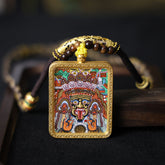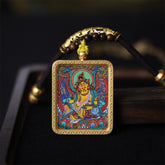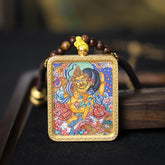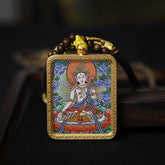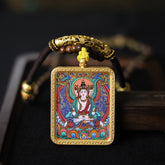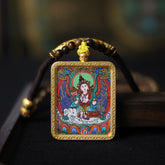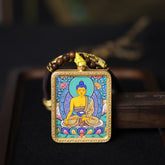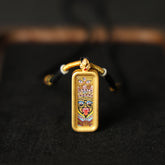The Origin and Evolution of Thangka: A Cultural Encyclopedia of Tibet
Hey there, I’m Chen—an ex-engineering geek who stumbled into the Thangka world a decade ago and never left. One of the most common questions I get from my Western clients is, “So, did Thangkas just pop out of thin air?”
Today, let’s peel back the layers of history and explore how Thangkas evolved from ancient pottery designs to a modern symbol of “Wisdom Lifestyle”—a journey more riveting than any Marvel hero’s origin story!
Thangka’s “Baby Steps”: When Pottery Became Art
I’ve seen the 15.4cm-tall spherical pottery jar at the Karuo Culture site in Tibet. To archaeologists, its triangular broken-line patterns are the “sprouts of Tibetan painting.” To me, a former engineer, they’re like the basic coding language of Thangka art—laying the foundation for how this art form would “program” stories later on.

▲Karola pottery pot in Xizang
Back then, around 4,000-5,000 years ago, Tibetan ancestors weren’t painting deities yet, but they were already using lines to “tell stories” on pottery. Can you imagine? These simple patterns were the first seeds of the “narrative DNA” that Thangkas would later become famous for.
From Temple Walls to Portable Art: The Birth of Thangka
In the 7th century, as the Tibetan Empire rose, temples and palaces were built in a frenzy. Artists covered walls and ceilings with mind-blowing murals. The details were so intricate, even a detail-obsessed guy like me was in awe. But murals are “fixed in place”—so how did believers take their deities with them?

▲Mural paintings of the Tubo Dynasty
Enter the “ancestors” of Thangkas: Some say they evolved from Tibetan banner paintings, others claim they’re distant relatives of Indian cloth deities. I once talked to an elderly artist named Dekyi in Nepal, and she put it perfectly: “Just like Westerners moved oil paintings from churches to canvases, we condensed murals into Thangkas.” Around the mid-10th century, Thangkas as we know them officially “debuted.”
Thangka’s Golden Age: Where Art Met Royalty (and Religion)
Most surviving Thangkas date from the Ming and Qing dynasties—not because ancient artists were lazy, but because paper and silk are incredibly fragile. During the Qing Dynasty, the 5th Dalai Lama recruited top-tier artists to decorate the Potala Palace, and later established an official art academy called Lhari Pelgyi Shedra.
I’ve had the privilege of handling an 18th-century Thangka original. The artist blended the delicacy of Han Chinese fine brushwork with the sacredness of Tibetan painting—like mixing coffee and Tibetan butter tea into a perfect brew. During the 7th Dalai Lama’s time, artists were high monks with dual “buffs” of Buddhism and artistry. Their Thangkas made religious followers feel devoted and art collectors drool—this was Thangka’s “golden era.”
Thangka for You: How This Ancient Art Fits Your “Wisdom Lifestyle”
• Mindfulness/Meditation Enthusiasts: The ritualistic feel of early Thangkas aligns perfectly with the focus you seek in meditation. Go for a Green Tara Thangka (the oldest surviving Thangka is of her!). Hang it in your meditation nook—its energy is unmatched.

• Fashionistas: Think Thangkas are only for walls? Our mini Thangka pendants blend 19th-century art elements with silver jewelry. A client in New York paired one with a denim jacket last week and dominated the street style scene.

• Art Collectors: 18th-19th century Thangkas are “blue chips,” but limited-edition pieces by modern master artists are worth investing in too—just like contemporary art, you’re buying the scarcity of cultural heritage.
Editor’s Picks
Zaki Ram Thangka Necklace, Daily Series
- $199.00 USD
$234.00 USD- $199.00 USD
- Unit price
- / per
Yellow Jambhala Thangka Necklace, Daily Series
- $199.00 USD
$234.00 USD- $199.00 USD
- Unit price
- / per
Yellow Jambhala Thangka Necklace - Master Series
- $599.00 USD
$704.00 USD- $599.00 USD
- Unit price
- / per
White Tara Thangka Necklace-Master Series
- $699.00 USD
$822.00 USD- $699.00 USD
- Unit price
- / per
Vairocana Buddha Thangka Necklace, Daily Series
- $199.00 USD
$234.00 USD- $199.00 USD
- Unit price
- / per
Six-Armed Mahakala Thangka Necklace, Daily Series
- $199.00 USD
$234.00 USD- $199.00 USD
- Unit price
- / per
Samantabhadra Bodhisattva Thangka Necklace, Daily Series
- $199.00 USD
$234.00 USD- $199.00 USD
- Unit price
- / per
Sakyamuni Buddha Thangka Necklace, Master Series
- $599.00 USD
$704.00 USD- $599.00 USD
- Unit price
- / per

